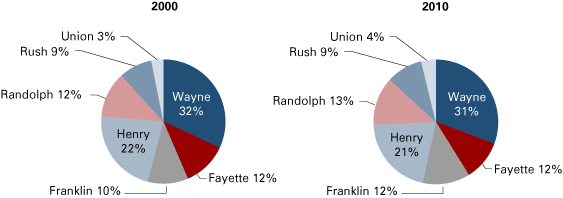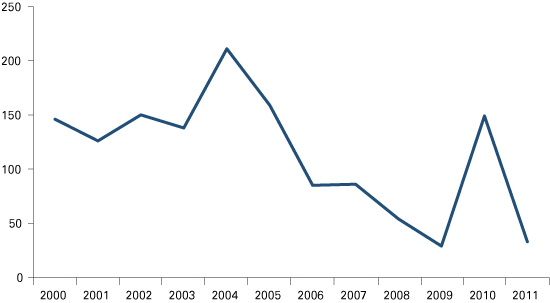Richmond Forecast 2013
Assistant Professor of Economics and Finance and Director of Business and Economic Research Center, School of Business and Economics, Indiana University East
Richmond (Wayne County) is at an intersection to redefine itself after a large-scale loss of its historically dominant manufacturing jobs in recent years. The overall economy in Wayne County continues to recover after the Great Recession, but at a much slower pace than the state and other counties. There are several big problems hanging over our region: high unemployment, a declining and aging population, a tepid housing market, and the shortage of skilled workers. The main question Wayne County faces today is not just how to recover from the recession, but how to reshape its economic structure and revitalize its economy and community.
This article provides an overview of Wayne County and surrounding counties in regard to recent economic performance and an outlook for 2013. The surrounding counties are Fayette, Franklin, Henry, Randolph, Rush and Union. This article mainly focuses on Wayne County, but also analyzes some key economic indicators for these surrounding counties.
Total Personal Income
Since the public regional gross domestic product (GDP) data are unavailable for Wayne County and surrounding counties, we used total personal income (TPI),1 as an approximation for GDP to measure the overall economic activity in our region. The regional total TPI bounced back in 2010 after the 2009 slump (see Figure 1).
Figure 1: Richmond Region’s Total Personal Income, 2000 to 2010

Note: The Richmond region includes Fayette, Franklin, Henry, Randolph, Rush, Union and Wayne counties.
Source: Bureau of Economic Analysis Regional Fact Sheets
Our region had a TPI of $6.5 billion in 2010 and accounted for 2.9 percent of the state total. Comparatively, the TPI of our region was $5.4 billion in 2000 and accounted for 3.3 percent of the state total. At the county level, Wayne still has the largest share of TPI in our regional economy, but its share fell from 32 percent in 2000 to 31 percent in 2010 (see Figure 2). Fayette and Henry counties also declined in their economic weights, while Franklin, Randolph and Union counties gained more shares in the regional economy. Rush County remained the same.
Figure 2: The Breakdown of Regional Total Personal Income, 2000 and 2010

Source: Bureau of Economic Analysis Regional Fact Sheets
Per capita personal income (PCPI) has gradually improved in the past decade (see Figure 3). In 2010, the regional PCPI was $29,928, about 88 percent of the state average ($34,028) and 75 percent of the national average ($39,791). Wayne County had a PCPI of $28,916 in 2010, ranking 74th in the state and reflecting an increase of 0.1 percent from 2009. The 2009-2010 state change was 2.0 percent and the national change was 2.8 percent. In 2000, the PCPI of Wayne County was $24,442 and ranked 46th in the state. Wayne County’s 2000-2010 annual growth rate for PCPI was 1.7 percent, compared to 2.2 percent for the state and 2.8 percent for the nation.2
Figure 3: Per Capita Personal Income for Wayne County and Region, 2000 to 2010

Source: STATS Indiana, using Bureau of Economic Analysis data
Interestingly, the surrounding counties’ PCPIs fall into two distinct groups (see Figure 4). Fayette County and Henry County have the same downward trend on their PCPIs as a percent of the national average as Wayne County does. In contrast, Franklin, Randolph, Rush and Union have a notable uptick on their PCPIs in terms of percent of the national average since 2007. This outcome echoes the percentage changes of regional TPI shown in Figure 2.
Figure 4: Per Capita Income as a Percent of the United States, 2000 to 2010

Source: Bureau of Economic Analysis Regional Fact Sheets
Population
Like other rural areas in the Midwest, Wayne County has been experiencing a sustained population decline, and the spiral down will continue in the foreseeable future (see Table 1). The population in 2011 was 68,643, which was 4.6 percent lower than in 1990. The projected population in 2030 according to the Indiana Business Research Center (IBRC) is 65,321, down 9.2 percent from 1990. The surrounding counties’ population will follow the same path as that of Wayne County except Franklin and Union counties. Both Franklin and Union counties have had a steady increase in their population since 1990, and this upward trend is projected to continue.
Table 1: Population over Time and Projections for Wayne County, 1990 to 2030
| 1990 | 1996 | 2001 | 2006 | 2011 | 2015* | 2020* | 2025* | 2030* | |
|---|---|---|---|---|---|---|---|---|---|
| Total Population | 71,951 | 72,019 | 70,513 | 68,551 | 68,643 | 68,110 | 67,142 | 66,250 | 65,321 |
| Change since 1990 | n/a | 68 | -1,438 | -3,400 | -3,308 | -3,841 | -4,809 | -5,701 | -6,630 |
| Percent Change since 1990 | n/a | 0.1% | -2.0% | -4.7% | -4.6% | -5.3% | -6.7% | -7.9% | -9.2% |
*Data are projected.
Source: Hoosiers by the Numbers, using U.S. Census Bureau and Indiana Business Research Center data
The age makeup of Wayne County’s population has also changed in the past decade. The median age was 37.8 in 2000, 39.5 in 2005 and 40.5 in 2011. The largest population group by age was young adults (age 25 to 44) in 2000, about 27 percent, while it was older adults (age 45 to 64) in 2011, about 28 percent (see Figure 5). This trend shows that the population in Wayne County is aging, which has implications for economic growth. Compared to its six neighboring counties, Wayne County had the lowest median age in 2011, while Henry County had the highest median age of 41.8. At the same time, our region’s median age of 41 was much higher than the state (37.1) and national (37.3) median ages.3
Figure 5: Population by Age for Wayne County, 2000, 2005 and 2011

Source: STATS Indiana, using U.S. Census Bureau data
Labor Market
The overall unemployment rate has slowly trended down since 2010 in this area (see Figure 6). The regional unemployment rate for September 2012 was 8.6 percent. Although the regional unemployment rate is on a downward trend, it is still higher than the national rate of 7.6 percent and the state’s 7.5 percent rate (not seasonally adjusted). Among all seven counties, the unemployment rates of Fayette, Henry, Randolph and Wayne are above the state and national levels, while Franklin, Rush and Union have unemployment rates lower than the state and national rates.
Figure 6: Unemployment Rates, January 2005 to September 2012

Note: Data are not seasonally adjusted.
Source: STATS Indiana, using Bureau of Labor Statistics data
The downward trend in the unemployment rate does not tell the whole story about the regional labor market. The data on the labor force and employment for all seven counties actually may raise some eyebrows. The labor force and employment numbers have both seen a substantial decrease, particularly since May 2012 (see Figure 7). Before May 2012, the labor force stayed around 99,000 with employment around 89,000, but in August 2012, the labor force slumped to 96,281 with employment of 87,344. This suggests that the local labor market is weakening with fewer available jobs, causing job seekers to drop out of the labor market or move out of the area.
Figure 7: Labor Force and Employment for the Region, January 2011 to September 2012

Source: Indiana Department of Workforce Development, Local Area Unemployment Statistics (LAUS)
The employment pattern has also been shifting in our region. Total nonfarm jobs totaled 64,114 in 2011, about an 11 percent slide since 2007 (see Table 2). The top five local employment sectors are: government, manufacturing, health care and social assistance, retail trade, and accommodation and food service.
Table 2: Employment by Sector for the Richmond Region, 2007 to 2011
| 2007 | 2008 | 2009 | 2010 | 2011 | Change since 2007 | Percent Change 2007–2011 | |
|---|---|---|---|---|---|---|---|
| Total Employment | 72,125 | 70,093 | 65,211 | 63,369 | 64,114 | -8,011 | -11.1% |
| Manufacturing | 15,502 | 14,051 | 11,783 | 11,550 | 11,854 | -3,648 | -23.5% |
| Retail Trade | 8,902 | 8,665 | 8,207 | 8,088 | 8,146 | -756 | -8.5% |
| Health Care and Social Assistance | 8,617 | 8,530 | 8,806 | 9,067 | 9,535 | 918 | 10.7% |
| Accommodation and Food Service | 5,657 | 5,955 | 5,795 | 5,532 | 5,657 | 0 | 0.0% |
| Federal, State, and Local Government | 13,307 | 13,294 | 13,117 | 12,697 | 12,380 | -927 | -7.0% |
Note: The Richmond region includes Fayette, Franklin, Henry, Randolph, Rush, Union and Wayne counties.
Source: Indiana Department of Workforce Development data aggregated by the author
Manufacturing used to be the largest employment source in this area, but its weight in overall employment has gradually declined from 21.5 percent in 2007 to 18.5 percent in 2011. Most sectors experienced job cuts during this time frame with the exception of health care and social assistance. There has been a steady increase in employment in health care and social assistance over the years in our region. We anticipate this economic sector will keep growing in the future and will become the largest source of employment in the region.
Earnings
In contrast to the weakening labor market, our region sees a positive change in the average annual income for most industries. In 2011, the average annual earnings for all industries was $30,703 (see Table 3), a 1.8 percent increase from 2007; however, that is about 23 percent lower than the state average. Although the manufacturing sector still has the highest wage in this region, comparatively its average annual earnings dropped by about 2 percent in the past five years. We anticipate the average income will grow steadily under the current economic circumstances, but the earning disparity between our region and the state average will persist for a long time.
Table 3: Average Annual Earnings by Industry for the Richmond Region, 2007 and 2011
| 2007 | 2011 | Change | Percent Change | 2011 State Average | Percent of State | |
|---|---|---|---|---|---|---|
| All Industry | $30,156 | $30,703 | $547 | 1.8% | $39,969 | 76.8% |
| Manufacturing | $45,185 | $44,322 | -$863 | -1.9% | $55,401 | 80.0% |
| Retail Trade | $19,241 | $20,364 | $1,123 | 5.8% | $23,442 | 86.9% |
| Health Care and Social Assistance | $28,564 | $29,805 | $1,241 | 4.3% | $40,838 | 73.0% |
| Accommodation and Food Service | $10,310 | $11,535 | $1,225 | 11.9% | $13,528 | 85.3% |
| Federal, State, and Local Government | $29,669 | $31,573 | $1,904 | 6.4% | $40,086 | 78.8% |
Note: The Richmond region includes Fayette, Franklin, Henry, Randolph, Rush, Union and Wayne counties.
Source: Indiana Department of Workforce Development data aggregated by the author
Housing
The local housing market reveals mixed information. Building permits were way off the peak of 211 in 2004. However, there was a surprising jump in 2010 to 149 permits from 29 in 2009 (see Figure 8), followed by a disappointing drop in 2011 to 33 permits. There were 503 house sales in Wayne County in 2012 (through October 1)—an increase of 56 sales relative to 2011.
Figure 8: Wayne County Building Permits, 2000 to 2011

Source: STATS Indiana, using Bureau of Labor Statistics data
Furthermore, the average sale price of $91,465 represents a 10.7 percent increase over 2011 (see Figure 9). Even with the exciting news of increased home sales, there is a longer waiting period to dispose of remaining houses for sale. The average number of market days is 155, up from 128 days in 2005. Surely, the housing market, which has experienced the adverse effects of the 2008 financial crisis, is moving toward the bright side of full recovery.
Figure 9: Housing Sales Details for Wayne County, 2005 to 2012

*2012 data are from January to October 1.
Source: Paragon-Wayne County MLS Service
Business and Investment Activity for 2012
In 2012, the Economic Development Corporation (EDC) of Wayne County did an excellent job partnering with existing companies to expand their production lines, as well as attracting new investments.
The EDC closed eight projects in 2012 which anticipate generating $39.5 million in new private investments. Those projects created or retained about 458 jobs. The new projects invested in by the EDC through 2012 were:
Golden Engineering, Inc. purchased new manufacturing equipment to add new product lines.
Silgan White Cap purchased new equipment and provided training for employees using the equipment to increase technological advantage.
Hill’s Pet Nutrition trained its employees and will create 12 new jobs by 2013.
Transilwrap Company added new equipment that will lead to new technology and jobs.
Suncall America, Inc. expanded its operation for its new automotive orders. It will create 10 new jobs.
Berry Plastics Corporation created 10 new jobs and invested $4.4 million in a new project.
B & F Plastics, Inc. added a new product line and created eight new full-time jobs.
Sugar Creek Packing Company announced the relocation to Wayne County. The new business will create 400 jobs and install five cooking lines by 2016.
Outlook
The global economy has much more impact on the regional economy today than 20 years ago. The World Bank’s new chief economist, Kaushik Basu, said “The ongoing European debt crisis could weigh on the world economy for years, forcing policy makers to rethink their approaches to restoring growth and boosting job creation.” 4
The sluggish global economic growth will impact the U.S. economy, which in turn will impact Richmond’s regional economy given their interdependence. Furthermore, many businesses have been waiting for clearer economic policies to be defined by the outcome of the general election.
In summary, due to policy uncertainty in the global and national economies, the outlook for the regional economy in 2013 is mixed. Overall, we expect moderate economic growth; however, in some sectors, such as health care and social assistance, we might see faster growth.
Notes
- Total personal income includes net earnings by place of residence; dividends, interest, and rent; and personal current transfer receipts received by residents in the area.
- Source: Bureau of Economic Analysis Regional Fact Sheets.
- Median age was calculated by the IBRC and by the author using U.S. Census Bureau data.
- “World Bank Sees Long Crisis Effect,” Wall Street Journal, October 2, 2012.
Also in this Issue…
- International Outlook for 2013
- U.S. Outlook for 2013
- Financial Outlook for 2013
- Indiana's Outlook for 2013
- Indiana's Agricultural Outlook for 2013
- Three Key Indicators—Forecasts for Jobs, Income and Productivity
- Anderson Forecast 2013
- Bloomington Forecast 2013
- Columbus Forecast 2013
- Evansville Forecast 2013
- Fort Wayne Forecast 2013
- Gary Forecast 2013
- Indianapolis-Carmel Forecast 2013
- Lafayette Forecast 2013
- Louisville Forecast 2013
- Muncie Forecast 2013
- Richmond Forecast 2013
- South Bend and Elkhart Area Forecast 2013
- Terre Haute Forecast 2013




